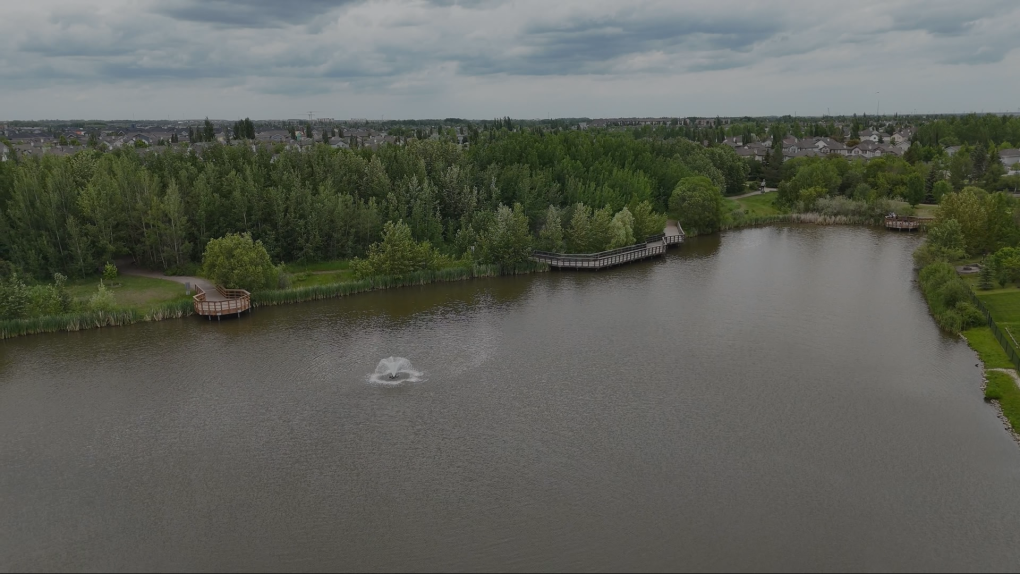Residents raise concerns over use of chemical in stormwater ponds to combat invasive goldfish
Residents of a southwest Edmonton neighbourhood are calling into question the use of a pesticide called harmless to humans by the utility that manages their stormwater ponds.
Epcor manages Edmonton’s drainage system, including bodies of water such as the Keswick Stormwater Management Facility, where it has been using a broad-spectrum pesticide to kill invasive species of fish, specifically goldfish.
The utility informed residents in Keswick — a southwest community located at the western edge of Ellerslie Road, south of the Windermere Golf and Country Club and adjacent to the North Saskatchewan River — it has hired a contractor to fence off the neighbourhood’s three stormwater ponds and treat the water with a chemical treatment including rotenone, which Epcor says has been used successfully over the last five years.
The province requires Epcor to keep stormwater facilities free from invasive species such as goldfish to prevent spread to waterways such as the river.
In literature sent to people living in Keswick, Epcor called rotenone “not harmful to humans,” a claim some residents say is false.
John O’Connor told CTV News Edmonton he is “sort of jarred” by the claim.
“It didn’t take much research to find out that it definitely is harmful and has been banned in many jurisdictions and restricted in others,” he said on Tuesday.
O’Connor said, “after some digging,” he and others also found out Epcor would be using a solution of hydrocarbons he says are carcinogenic.
“In the U.S., those are on a right-to-know, hazardous substance list, so if you are going to experience this in your neighborhood, you have to be called beforehand in the U.S.,” he said.
 A stormwater pond in the southwest neighbourhood of Keswick. (CTV News Edmonton)Angus Grant, the senior manager of wastewater collection operations for Epcor, said the application of rotenone — which has been approved by Health Canada for the control of invasive species such as goldfish — is done “in accordance with the label rates.”
A stormwater pond in the southwest neighbourhood of Keswick. (CTV News Edmonton)Angus Grant, the senior manager of wastewater collection operations for Epcor, said the application of rotenone — which has been approved by Health Canada for the control of invasive species such as goldfish — is done “in accordance with the label rates.”
“At those rates, they have been identified by Health Canada to be safe,” he told CTV News Edmonton on Tuesday.
Grant said workers applying the solution to the water are wearing personal protective equipment in accordance with regulations and dilute chemicals down from concentrate before using it.
He said Alberta Environment and Protected Areas has been communicating with residents over several months and will continue to listen to their concerns about the process, adding that the application of the solution including rotenone is “not normal, everyday practice.”
“We only intervene in these circumstances when it’s absolutely required,” he said.
Rotenone has been used in other places across Canada, including St. Albert in 2017 and 2018, to cull goldfish and other invasive species.
Melissa Logan, the City of St. Albert’s environmental coordinator for the Sturgeon River and natural areas, says an extensive communication plan for residents on the impact of rotenone before its use in three stormwater facilities there helped alleviate concerns.
“We worked closely with Alberta Environment and Parks to ensure the information about the rotenone and the impacts of that were well-communicated and very clear,” Logan told CTV News Edmonton on Tuesday, adding the impacts of rotenone are generally short-term.
“I think the success of our efforts were fully based around that communication (with) our residents.”
With files from CTV News Edmonton’s Nicole Weisberg and Kerry McAthey
View original article here Source









